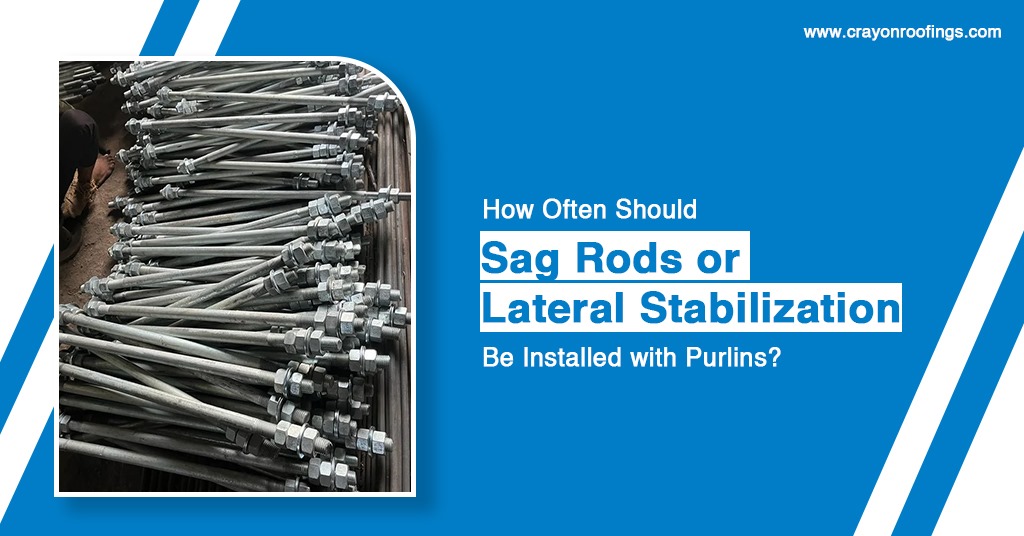Introduction
If you’ve ever been involved in putting up a metal building, especially one with steel roofing, chances are you’ve come across the word purlins. Think of them as the unsung heroes of your roof. They hold the sheets firmly in place and help shift the weight down to the building’s main frame, keeping everything steady and secure. However, purlins will not always be sufficient alone and might require support, especially in large buildings or buildings exposed to wind. Sag rods or lateral support would likely be needed to stabilize and support the purlins. So, how often would the sag rods of lateral supports need to be installed?
In this blog, we will discuss and answer questions that several site engineers and contractors ask. Whether you are obtaining purlins from purlin manufacturers or you want to build a long-span metal roof, this blog will help you make more informed and secure decisions.
Let’s cover good practices, spacing standards, and other key considerations regarding purlin steel systems for 2025 and beyond.
What Are Purlins and Why Do They Need Stabilization?
An Overview of Steel Purlins
Purlins are horizontal members in roof systems that provide support for the metal sheeting. They are often cold-formed steel, including C and Z sections.
The Problem Without Support
Purlins will bend or twist when subjected to heavy vertical loads if there is no support in the lateral or vertical direction. Over time, this can lead to:
- Roof sag
- Structural stress
- Reduced exposure to life
That’s where sag rods and lateral restraints provide support for purlins by ensuring they stay in their intended location, maintain an appropriate load path, and limit distortion.
How Often Should Sag Rods Be Installed?
Industry Standards for Sag Rod Placement
Sag rod installation frequency can usually be accounted for by several factors:
- Purlin span: Longer spans require more support.
- Roof load: Heavier roofing materials or high wind zones require tighter spacing.
- Purlin type: C-purlins require more bracing than Z-purlins because of their shape.
General Guideline:
For most projects, sag rods are installed every 3 to 4 meters, but always refer to the structural engineer’s recommendations.
Lateral Stabilization – When and Where Is It Needed?
What Is Lateral Restraint?
Lateral restraints control the lateral movement of purlins and are often placed:
- At purlin’s midspan
- At the junction of the ridge and eave
- Near openings such as skylights
Placement Frequency
- With Z-purlins, lateral support is normally required every 3rd-4th bay.
- In high wind or seismic zones, the spacing can be reduced to every bay.
Common Mistakes to Avoid During Installation
Skipping Supports in Long-Span Structures
A large warehouse or industrial building roof with little sag rods or bracing runs the risk of premature failure.
Using Incompatible Materials
Using dissimilar grades of steel or supports that are not aligned weakens the system.
Not Consulting the Purlin Manufacturer
Every steel purlin system has specific load ratings from the manufacturer. Without doing proper research and following the recommended guidelines, you may have an unsafe installation.
Benefits of Proper Sag Rod and Lateral Support Installation
- Provide for the structural integrity of the roof, preventing collapse.
- Increase the life of the purlins.
- Assists in the alignment of the roof sheets
- Lessens long-term maintenance costs
- Follows building code and safety compliance
Best Practices from Top Purlin Manufacturers
Engineering Backed Recommendations
Leading purlin manufacturers recommend the use of sag rods in all structures greater than 10 meters in span and where roofing loads exceed 0.75 kN/m².
Factory Pre-punched Holes
Leading purlin steel products today offer factory-prepunched holes, which make the installation of sag rods and lateral braces faster and more accurate.
How Crayon Roofings Handles Purlin Installation
All metal buildings built by Crayon Roofings are engineered with sag rods and lateral support, making sure that we are following the standards set by the industry. We work with reputable purlin manufacturers to achieve longevity. Whether you’re building a factory, warehouse, or commercial building, Crayon Roofings will have dedicated experts who strictly follow IS-code guidelines while only using tested steel purlins with certified bracing methodologies.
Conclusion
As an engineer, architect, or contractor, it is important to know how often sag rods or lateral stabilization should be installed with purlins in order to keep the structure safe. There are no universal standards across all buildings. Each installation will differ depending on span, wind zone, and steel types.
As always, follow the instructions provided by your manufacturer, use good-quality steel purlins, and always install bracing where necessary. Do you need help determining the correct purlins and supports? Contact our experts at Crayon Roofings are here to help you with whichever stage you’re at – whether that is the material selection or safe installation procedures.
FAQs About Purlin Supports
H3: Can I install sag rods after the roof is completed?
It is best to install sag rods at the time of building, but retrofitting sag rods for installation after the roofing is done is possible, though potentially more expensive and complex.
H3: Do I require lateral bracing for all purlin systems?
Not necessarily, but if using a steel structure with a wider span, it typically requires lateral bracing to prevent torsional buckling.
H3: Can I use angle sections instead of sag rods?
Yes, provided that you have your structural engineer’s approval. Sag rods are easier to install and do offer good tension resist

